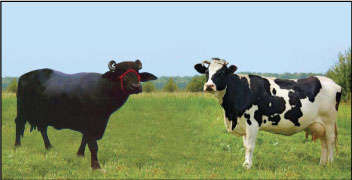
Animal HusbandryAgrowon
Important factors for rearing cows and buffaloes
India is an agricultural country and in rural areas, cows and buffaloes are considered as an important factor for milk production. This business provides self-employment in rural areas. So, scientific methods of animal rearing are essential for financial benefits.
Selection of cows and buffaloes and signs of healthiness-
1. While selecting cows and buffaloes, the breed, characteristics of the breed, color, form, build and genealogy of the animals needs to be checked.
2. If animal purchases are likely to be done from a cattle rearer, then the information about birth, pregnancy, average milk production, vaccination etc. can be obtained.
3. Animals should be purchased when they are pregnant or they have conceived two or three times. Their age should be about four years. Waist bones of the animals should be well apart so that growth of embryo and delivery becomes easier.
4. Cows and buffaloes should be healthy. Their healthiness can be seen from soft and glowing skin and moist nose. Eyes should be snow-white and watery. If touched, their skin should give warm and soft feeling.
5. Healthy animal always appears to be alert and clever and its ears are raised.
6. Healthy animal always walks enthusiastically. Diseased animal remains inactive at one place.
7. While purchasing, take the animal for a walk around. Any defect in legs or difficulty in walking can be known.
Balanced Diet -
1. The amount of green fodder, dried fodder and cattle feed in animal feed should be decided in a scientific way. Dry diet of 2.5 to 3 percent of their body weight is necessary for animals.
2. For each liter of milk, animals require 300 to 400 grams of nutritious animal feed. To recover elements like Calcium and Phosphorous given away with milk, provide 50 to 100 gram of alkali mixture with the animal feed.
3. Feed the milking cows and buffaloes 4 to 5 times through out the day.
Cattle shelter -
1. Plan the cattle shelter by considering the increase in the number of animals in future. About 65 to 75 square feet space should be available for each animal.
2. Sufficient free space should be available for cows and buffaloes to move around.
3. There should be plenty of sun-light and natural air flowing in the cattle shelter.
4. Around the cattle shelter, make a compound fence using frame nets.
Vaccination -
Timely vaccination should be done to avoid disease attack in animals. Vaccination helps to stop attack of the diseases like Diphtheria, Black leg, Foot and Mouth disease, Anthrax, IBR, Theileriosis, etc.
Veterinary advice -
Symptoms of any disease or discrepant behavior of any animal if observed, consult the veterinary doctor immediately.
Reference- Agrowon 14th October 17
59
1

